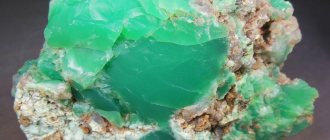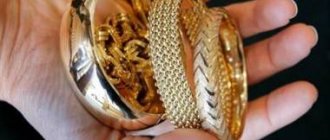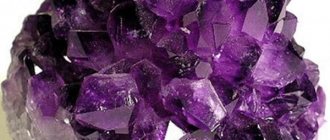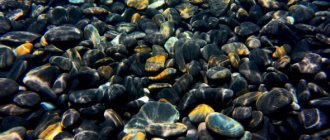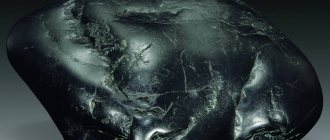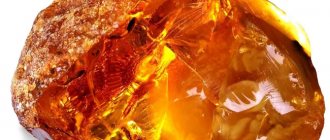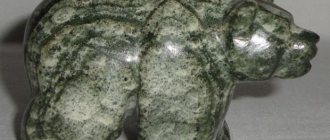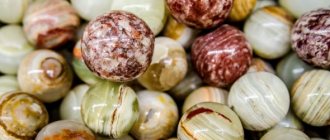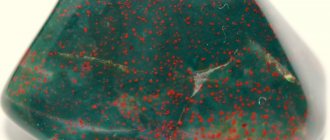Coral is a very interesting stone, primarily due to its unusual organic origin.
It is created by coral polyps living in warm tropical seas. Humanity has known about this unique mineral for quite a long time - at least since the beginning of our era. However, the history of coral may be coming to an end, and our children will no longer be able to buy a unique talisman. Due to increasing pollution of the world's oceans, the number of coral polyps is steadily declining. Nevertheless, for now you can still find relatively inexpensive jewelry - of course, if it suits your energy.
Coral stone in history
Coral is a name that comes from the ancient Greek word "coralion". According to one version, it means “the depths of the sea,” according to another, “hardening in the hand.” In the ancient world, the fashion for wearing talismans from the depths of the ocean was spread by Celtic tribes, but what they called them is unknown.
Living polyp corals.
In Rus', sea corals were sometimes called “kings” - this is a folk etymology that emphasizes the “royal” beauty of the stones. They were used everywhere as protective talismans and magical amulets. They also paid tribute to the decorative properties of organic material. Figurines were cut out of it and finishing tiles were made. Clothes were also decorated with coral beads.
In Poland and Ukraine, as well as in some other countries, coral beads are considered an integral part of ethnographic women's costume. In the old days, it was believed that the more such jewelry a girl put on, the richer and more wealthy her family was. The stone was usually brought from the south, from the Red Sea, by Turkish or Italian merchants.
Today, the tropical mineral is still loved by jewelers. It is very easy to process, so the products can come out the most bizarre and beautiful - it all depends only on the imagination of the master. The magical properties of coral stone have made it popular among people who practice magic or alternative medicine.
Decorations
Various jewelry, as well as amulets, rosaries, and magical attributes are made from coral.
Traditionally, jewelers set the stone in gold or silver. They decorate earrings, rings, bracelets, brooches, and hair clips with gemstones. But the most common coral product is beads.
Place of Birth
The mineral is mined in tropical waters. Since coral is, in fact, the remains of living beings, it grows on its own in the favorite places where polyps live. These include the seabed at a depth of 3-5 meters. Some kind of “bushes” form there. Previously, they dived for them, now they catch them with a special net.
Black corals are one of the most valuable.
After extraction, such a “bush” is processed: all soft parts that have not had time to become saturated with sea salt and crystallize are removed. The stones are then sorted by appearance and defects. Only after this can they be carried for sale.
Coral is harvested on an industrial scale where climate conditions allow it to grow as densely as possible. This requires extensive shallows and an average annual temperature of around twenty degrees. The following countries actively supply stones to the market:
- Italy;
- Algeria;
- Tunisia;
- Australia;
- Egypt;
- Canary Islands;
- Samoa;
- Japan.
Stones of a black or deep dark blue hue are very highly valued. They are mined in the Red Sea, on the islands of the Malay Archipelago, as well as along the coast of India. Unfortunately, the number of polyps in these places is now declining.
MINERAL, STONE OR ANIMAL?
Coral is considered a precious stone. However, the very definition of “stone” is not very suitable for it.
A hard, easily processed and polished mineral of organic origin is formed from the skeletons of polyps.
What is natural coral?
This is not just an animal, but a real predator. Coral colonies develop well thanks to the “Mediterranean diet” - they feed on phytoplankton, small fish and shrimp. And yet, corals are not quite ordinary living microorganisms: they do not have respiratory organs or senses.
Natural coral
Chemical composition
Natural coral stones in their composition are a real “bomb” of calcium, to which microorganisms owe their strength. In addition to calcium, the stone is formed by iron oxide and magnesium carbonate.
Physical properties
- On the 10-point Mohs scale, which measures the hardness of minerals, the stone received a rating of 3.5-4 points. This is more than amber, and the same as malachite and jet.
- Stones with a hardness of up to 5 units are easily scratched with a knife and are not resistant to water.
- Coral density is 1.3-2.6 g/cubic. cm.
- The untreated stone is matte, but after polishing it acquires an attractive waxy shine.
- The mineral may have irregularities, cracks or stains, but some jewelers prefer to work with such imperfect stones.
Place of Birth
- Corals, for the most part, are thermophilic and grow in seas and oceans where the water temperature does not fall below 21 degrees Celsius.
- Microorganisms develop mainly during the day under ultraviolet radiation, so choose the depth where sunlight penetrates: from 5-30 to 300-6000 meters.
- Some types of corals are so harsh that they live in cold northern waters and at depths where it is difficult for the sun's rays to penetrate.
Red sea
The stone is mined all over the world:
- There are mineral deposits in Australia, the Canary Islands, Hong Kong, near Mexico and Hawaii, and in the Mediterranean Sea.
- The Red Sea, the Malay Archipelago, and the coast of India are the places where the most expensive black corals grow.
- The Samoan Islands have deposits of red and blue minerals.
- In Japan, which has been strengthening its position as a supplier of sea gems in recent decades, dark red and pale pink stones are mined.
What does coral look like?
There are 6 thousand types of mineral in 350 different shades in the world. In addition to the classic red, there is white, orange, pink and blue coral.
On the seabed you can find stones growing in the shape of a mushroom, a ball, or an eight-pointed star. There are colonies that look like desert cacti, while others resemble tentacles or tufts of hair.
Blue coral is the rarest and most expensive gem, just like black: the extraction of the black mineral is limited, as it is listed in the Red Book. We recommend: TOP 5 PINK DIAMONDS
White coral
Powder, lime or jewelry
Corals are divided into three main groups.
- The most expensive specimens are of jewelry quality. The color and quality of the stones depend on the amount of organic substances in the composition. This indicator can vary from 1 to 100%.
- Less expensive, but no less varied in color palette are root and foam minerals. The root ones are bush-like, and the foamy ones form a transition from the hard to the soft part of the stone.
| Sponge coral |
|
| Madrepore |
|
| Noble |
|
Sponge coral
There are international names for corals that any jeweler can understand. Almost all the names of the stones have Italian roots: active trade in the organic mineral has been going on for a long time in the Neapolitan city of Torre del Greco.
Color names
- ROSSO, ROSSO SKURO - red coral. Highly valued by jewelers. Sometimes it costs even more than the rarest black mineral.
- Pink coral comes in two shades: ROSE PALLIDO - pale pink; ROSA VIVO - hot pink. SECONDO COLORO - salmon shade.
- Red corals have in their palette ARCISURO CARBONETTO - dark red, brown color.
- Blue coral - AKORI. The hue is due to iron salts. Grows in the waters of the Indian and Pacific oceans.
- Pink corals have a closest neighbor - PELLE D'ANGELO (angel skin) - a silvery-pearl mineral, which is sometimes tried to be passed off as pearls.
- AKKABAR is the rarest Indian black stone.
- BIANKO - white coral. Not highly valued. Unscrupulous sellers paint the mineral in other colors and try to sell it at a higher price.
Types of corals
The palette of corals is very rich. Biologists have identified more than two thousand varieties of polyps. Each of them creates its own unique type of stone. The color can be anything you can imagine. Since it is impossible to remember all these subtypes, there is a special jewelry classification that groups similar varieties into categories.
- The silvery-pink coral is called "pelle d'angelo" (angel skin in Italian).
- Bright stones the color of dawn are classified as “Rose Vivo”.
- White coral is classified as bianco. This is a very rare variety that is used only in jewelry.
- Pink-orange stones are called “second color”.
- Black coral is classified as the “Akkabar” subtype. It contains no calcium, only keratinized organic matter - dead polyps.
- Blue coral is also a rare variety. Bright specimens are especially valued - some “craftsmen” can even use it to imitate sapphires.
- The most classic variety is the bright red coral, “rosso”. This is what is mined off the coast of Italy and Algeria. Already in the Middle Ages it spread widely throughout Europe.
- Brown minerals are classified as “arquisuro carbonetto” type. These are usually small spongy specimens.
- The dark red coral is called "rosso scuro". It is mined in Japan and on the islands of Indonesia.
The color of coral depends on the ratio of organics and inorganics in the mineral. Completely organic specimens are black. They are very rare and are listed in the Red Book; they are not mined on an industrial scale. Jewelers are forced to be content with what the sea washes ashore.
Blue coral called “akori” is also very rare. It grows off the coast of Japan. Many stone carvers dream of making something from such a unique mineral at least once in their lives.
Types of coral and its colors
Natural mineral is divided into several types:
- Noble. Jewelers use this type in their craft, making various jewelry from it.
- Root. This variety resembles a small branched bush in its appearance.
- Foamy. This type of coral is a fusion of soft and hard rocks.
Since ancient times, masters have divided corals into shades, each of which has its own name:
- Akkabar (black, one of the rarest shades of the gem).
- Bianco (white).
- Rose pallido (pale pink).
- Rosa Vivo (hot pink).
- Pele d'angelo (pale pink, "angel skin").
- Second color (pink-orange).
- Arquiscuro carbonetto (ripe cherry).
- Rosso (red).
- Rosso scuro (dark red).
Also, in the depths of the sea, it is rare, but you can find coral reefs of green, blue and blue shades. The most expensive are blue and blue gems. In jewelry, the most commonly used mineral is a rich red hue.
It is also worth mentioning the properties of sponge coral. This type is the lowest grade and cheapest. This mineral in appearance resembles another sea creature - a sponge.
How to spot a fake
As polyp habitats have been threatened by pollution and intensive development, natural coral has become less common on the market than before. There are several technologies for growing artificial stones. They are much cheaper than natural ones. Some unscrupulous sellers sell such products at the price of genuine crystals.
The most similar to their natural counterparts are the so-called Gilson corals. They were invented in 1972, in laboratories in Switzerland. Such stones are grown from calcite powder. Their cost is much lower than that of natural minerals, but they look almost like real gems from the depths of the sea. However, there are still differences. If you examine such a crystal under a magnifying glass, you will not see a specific mesh pattern.
Another gem very similar to coral, but cheaper, is quartzite. To distinguish it from a king, it is enough to lightly press the purchase against the skin. Inorganic quartz will remain cold. The coral will warm up from the heat of the human body.
The cheapest imitations are created from pressed coral shavings. This is waste from mineral processing in jewelry workshops. Completely “budget” options that can’t even be called stones—just pieces of plastic or glass. Such fakes are easy to distinguish - they always have a uniform color. This happens very rarely with genuine crystals.
There are several universal authentication methods that were invented back in the Middle Ages. For example, you can carefully break off a small piece from a stone and throw it into vinegar. The natural crystal will react violently. If it stays in water for a long time, it will become brighter, but this will not happen with a fake. Finally, you can place the stone in a mug of milk. The natural mineral will color it pinkish.
WE BUY CORAL WISELY
Decoration will bring joy, protect against troubles and help improve health only if it is not fake.
We recommend: Luxury IMPERIAL TOPAZ
How to spot a fake
To pass off a trinket as a precious mineral, “craftsmen” use various methods of refining.
- The simplest fake is lightly processed LIMESTONE, which is painted in different colors. It is easy to distinguish such a “jewel” - the fake is lighter in weight and leaves a white mark on any surface. Such decoration will be scratched, and the paint will be easily erased from it.
- Sometimes they try to sell COLORED GLASS under the guise of corals. A fake can be distinguished by wiping it with a rag soaked in vinegar: the paint will easily rub off.
- Since the 70s of the last century, imitation coral has been produced in Switzerland. CALCITE is fired at a certain temperature and a stone is obtained that looks almost like the real thing, and even surpasses the sea mineral in density. Now artificial corals are available in 12 different shades. The price of calcite is lower than that of the original.
Application and care
Products made from coral come in a wide variety. Figurines, finishing tiles, and paperweights are cut out of large spongy stones. The more beautiful and brighter, but smaller specimens are used for decoration. The most popular method of processing such crystals is turning beads, from which they are then assembled into bracelets or beads.
There are various types of coral products. Beads and other jewelry are very popular.
In order for the properties of coral to be preserved as long as possible, it must be properly cared for. The mineral needs protection from mechanical damage - shocks, scratches, friction. It also does not tolerate hot baths - it is better to remove the gem in the sauna. It is advisable to put it on before applying perfumes and cosmetics - this reduces the likelihood that aggressive substances will get on the crystal.
It is not advisable to wash corals; it is best to simply brush gently with a soft toothbrush.
They are afraid of sea stones and household chemicals, so it is better to remove jewelry when preparing to start cleaning. It is advisable to store them separately from all other minerals.
When putting away for storage, you can wrap the gems in a light, breathable fabric; a budget option is thin cigarette paper. But it is undesirable to use plastic bags; living stones must breathe.
The meaning of coral in esotericism
Humanity became acquainted with coral as a stone with magical and healing properties back in ancient times. For example, the Maya Indians, who inhabit what is now South America, wore coral on their bodies in the form of beads. It was believed that such decoration drives away evil spirits from its owner and gives him good luck.
In Eastern countries, the gem was used in the manufacture of religious paraphernalia. Corals were also used in inlaying weapons, as it was believed that these stones gave a person protection from harm. In Ancient Greece, the stone symbolized prosperity, longevity and good health. For several hundred years, coral was valued as highly as pearls, so only very wealthy people could wear jewelry made from it.
Any type of coral, including black coral, plays the role of a talisman for all travelers. The stone gives a person protection when he is away from home, protecting him from the consequences of rampant elements, disasters, etc. In addition, coral helps a person strengthen his memory, develop the gift of foresight, gain wisdom and insight, as well as the ability to see beauty in ordinary things. things.
Coral strengthens the human biofield, so it provides its owner with protection from black magic, the evil eye, damage and the influence of ill-wishers. This stone helps a person preserve love and harmony in the family, as well as avoid betrayal by a life partner.
A coral talisman makes its owner more attractive and pleasant to members of the opposite sex, so it can be worn by those people who are looking for a life partner.
From an energetic point of view, coral is sensitive to changes in the phases of the moon. For example, during the waxing moon, coral is charged with energy that can heal a person. With the onset of the new moon and the waning moon, wearing items with coral should be avoided, since the stone can contribute to increased irritability and capriciousness of its owner.
Coral is also used in lithotherapy, because it acts as an indicator of human health. It has been noted that with an increase in body temperature and a change in the composition of human sweat, a stone in contact with the skin may lose its color and shine.
As for the health benefits of the stone, wearing coral products helps normalize metabolism, heart function and the health of the immune system. The gem also helps in curing skin diseases, tonsillitis, sinusitis, osteoporosis and other ailments. It is believed that the gem is beneficial for people prone to bleeding.
If a person wears a product made of coral, then such a useful habit can have a beneficial effect on his nervous system. Esotericists are confident that coral relieves its owner from conditions such as apathy, depression, emotional exhaustion and nightmares. Corals help a person reduce the risk of developing cancer, which is an undeniable advantage of this miracle stone.
As for astrology, corals favor Pisces and Cancers, who belong to the “water” signs, energetically compatible with the sea element. Representatives of the signs of the elements of Air and Fire can also experience the positive influence of corals.
As for products with black corals, such jewelry belongs to the exclusive class, since this stone is considered very rare and expensive. You can only purchase such an accessory in a branded jewelry store, and the jewelry itself will cost several tens of thousands of US dollars.
Jewelry made from any variety of coral is not suitable for constant wear, as it can fade and lose its attractiveness under the influence of dust, sun, human sweat and sebum. As for caring for products made from corals, they should not be treated with sharp objects or aggressive chemicals, as the stone may deteriorate under their influence.
Medicinal properties
These properties of corals have been noticed a long time ago. Wherever this stone was known, it was used in medicine. Thus, the Romans used the mineral to heal wounds and fractures. To do this, he was ground into powder, which was sprinkled on the injury site.
In antiquity they also believed that the gem helped fight insect bites, snake bites, and the effects of poisons. Today's lithotherapists still recognize such features in coral.
The talisman from the bottom of the sea is a very good healer.
The importance of coral for human mental health is also great. With the help of the stone you can overcome depression, improve sleep, get rid of neuroses and anxiety disorders.
Coral beads help with diseases of the throat and vocal cords. Lithotherapists advise wearing them to those people who need speech or singing as a professional instrument. These are singers, politicians, teachers. The stone also has a positive effect on blood circulation. It helps get rid of anemia, pressure changes, and reduce the development of symptoms of atherosclerosis.
By improving blood supply to the brain, the mineral helps preserve memory.
For those trying to lose excess weight, lithotherapists also recommend purchasing coral. It helps reduce appetite, so you will start eating less. The mineral also helps the body cleanse itself of waste and toxins.
It is believed that a coral amulet can warn the wearer of possible health problems. To do this, you should wear the talisman regularly, while carefully caring for it and paying attention to its appearance. When a stone loses its shine, black spots and cracks appear on it - this is a sign of problems in the body. In this case, it is better to visit a doctor to undergo diagnostic procedures.
Properties of coral
Coral has unique physical, healing and magical properties.
Physical properties
The main building material of the gem is calcium carbonate. In addition to it, it includes various impurities: magnesium, iron oxide, manganese. On the Mohs hardness scale, coral is rated 2-3 points. It is highly sensitive to ultraviolet radiation, hot temperature, and acid. Due to its porous structure, the stone fades over time and becomes covered with microcracks.
In its raw form, coral has an amorphous shape, an opaque matte sheen, and numerous cracks and irregularities. After processing, the mineral acquires a glassy sheen, a smooth surface, and a regular shape.
Magic properties
Modern psychics are convinced of the following magical properties of coral:
- For creative people, the stone helps them subtly sense the world around them. It promotes the development of intuition and extrasensory abilities.
- It is a powerful protective talisman against negative external influences: the evil eye, curses, love spells, damage, envy, and the anger of people around you. The mineral also protects travelers on the road and helps avoid minor troubles.
- Pink specimens are considered a talisman of family happiness and prosperity. They protect the couple from temptations, help maintain the sharpness of feelings and purity of soul.
Astrologers do not recommend wearing corals during the full moon or waning moon. Only during the growth of the Moon are such talismans able to benefit their owner.
Medicinal properties
Healers attribute the following medicinal properties to corals:
- Disinfecting and wound healing effect. It is believed that coral powder accelerates the healing of fractures and neutralizes intoxication from the bite of poisonous animals and insects. The Japanese use a white variety of coral to create dentures.
- Improving the condition of the skin - increases its elasticity, helps in the treatment of infectious skin diseases.
- Improvement of the nervous system - helps to get rid of depression, insomnia, and mental stress.
- Providing assistance for diseases of the throat and respiratory tract: asthma, sore throat, ARVI, vocal cord breakdown.
- Stabilization of the cardiovascular system, metabolism, normalization of blood sugar levels.
Lithotherapists claim that coral is able to warn its owner about an impending illness. In this case, it becomes covered with dark spots, loses its shine, and cracks.
Magic properties
It is also impossible not to mention the energetic properties of coral stone. In different countries, a variety of abilities were attributed to him. Thus, the ancient Greeks believed that the stone could prolong life and bring happiness. Many of them wore jewelry with the gem for decades without removing it.
Magical properties may vary slightly depending on color.
The Romans were inclined to believe that coral was the most reliable protection against evil spirits. Such properties are also recognized by modern psychics. According to their views, the stone makes the wearer invulnerable to damage, evil eyes, love spells, and curses.
The Hindus also believed in the protective power of the mineral from the depths of the sea. In this country, however, coral was considered not only a protective amulet, but also a stone of sages. It is believed that its aura enhances the magical abilities of the wearer.
Many researchers of the magic of stones are inclined to believe that coral protects the owner along the way. He helps you return home safe and sound. The stone can also protect a person from violence, both physical and emotional. At the same time, the energy of coral is very soft, so it is suitable even for small children. Thanks to the stone, babies will sleep better and get sick less.
Coral stone and zodiac signs
Compatibility with stones is a subject of debate and a rather vague concept. Astrologers assure: everything is ruled by the stars. So the constellation under which you were born indicates whether the talisman is suitable for you or not.
Coral stone can have different effects on representatives of different zodiac signs. Much also depends on the color.
- Pisces are compatible with a living gem better than all other signs. The mineral will help them become healthier and luckier. Red or brown specimens are most suitable for such people.
- The energy of Cancers also harmonizes well with coral, but it is better for them to prefer pink stones.
- Aries , Taurus , Sagittarius and Libra are able to achieve mutual understanding with the sea mineral. Its energy will help them not to be afraid of the effects of black magic. The crystal will also make such owners more attractive to the opposite sex and help them find friends.
- Scorpios and Leos can wear coral, but not too often. When used correctly, the stone will help them improve their health and prolong their life.
- Astrologers do not recommend using sea mineral for Virgos and Capricorns Their aura blocks the crystal's abilities.
It should be noted that astrological recommendations are not absolute. For example, the nature of the medium is of great importance. Coral does not like cruel, hypocritical, deceitful people. What is also important is how the stone came into your hands.
The ideal option is to find it yourself in the sea and process it yourself, but not everyone is capable of this.
A gem given to a loved one by a loving person will be a good amulet for everyone, regardless of their sign. Did you like the coral? We think you will also be interested in these stones: calcite, flint, aventurine. Enjoy reading!
